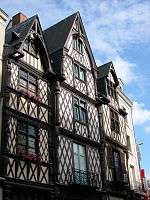Pays de la Loire
| Pays de la Loire | |||
|---|---|---|---|
| Region of France | |||
| |||
 | |||
| Country |
| ||
| Prefecture | Nantes | ||
| Departments | |||
| Government | |||
| • President | Jacques Auxiette (PS) | ||
| Area | |||
| • Total | 32,082 km2 (12,387 sq mi) | ||
| Population | |||
| • Total | 3,553,353 | ||
| • Density | 110/km2 (290/sq mi) | ||
| Time zone | CET (UTC+1) | ||
| • Summer (DST) | CEST (UTC+2) | ||
| ISO 3166 code | FR-R | ||
| GDP (2012)[1] | Ranked 5th | ||
| Total | €101.2 billion (US$130.2 bn) | ||
| Per capita | €27,775 (US$35,725) | ||
| NUTS Region | FR5 | ||
| Website | paysdelaloire.fr | ||
Pays de la Loire (French pronunciation: [pe.i də la lwaʁ]; Breton: Broioù al Liger) is one of the 18 regions of France. It is one of the regions created in the 1950s to serve as a zone of influence for its capital, Nantes, one of a handful so-called "balancing metropolises" (métropoles d'équilibre)¹.
Geography
Pays de la Loire is made up of the following historical provinces:
- Part of Brittany, with its old capital Nantes contained within the Loire-Atlantique department. This is only 20% of historical Brittany. The other 80% of historical Brittany makes up the region of Brittany
- Anjou: is largely contained within the Maine-et-Loire department; the whole of the former province of Anjou is contained inside Pays de la Loire.
- Maine: is now divided between the Mayenne and Sarthe departments; the whole of the former province of Maine is contained inside Pays de la Loire.
- Part of Poitou: is contained within the Vendée department; most of the old province of Poitou is inside the Poitou-Charentes region.
- Part of Perche: is within the northeast of Sarthe department; the rest of Perche is inside the Basse-Normandie and Centre regions.
- Small part of Touraine: southeast of Maine-et-Loire department; most of the former province of Touraine is inside the Centre region.
Thus the name of the region, chosen by the French central government, was not based on history, but purely on geographical references: Pays ("lands") de la Loire ("of the Loire"). The majority of the châteaux of the Loire Valley are located in the Centre-Val de Loire region, and not in Pays de la Loire.
The Pays de la Loire has numerous prominent monuments, such as the castles of Angers, Laval, and Mayenne, and the Nantes Château des Ducs de Bretagne, the Royal Fontevraud Abbey (the widest monastic ensemble in Europe), and the old city of Le Mans. In addition, it also has many natural parks such as the Brière and the Marsh of Poitou.
Demography
Evolution of the population listed by departments:
| Year | Population of the departments | |||||
|---|---|---|---|---|---|---|
| Loire-Atlantique department | Maine-et-Loire department | Mayenne department | Sarthe department | Vendée department | Total Pays de la Loire | |
| 1801 | 369,305 | 375,544 | 305,654 | 388,143 | 243,426 | 1,682,072 |
| 1851 | 535,664 | 516,197 | 374,566 | 473,071 | 383,734 | 2,283,232 |
| 1901 | 664,971 | 515,431 | 313,103 | 422,699 | 441,311 | 2,357,515 |
| 1921 | 649,691 | 475,485 | 397,292 | 2,174,150 | ||
| 1936 | 659,428 | 478,404 | 251,348 | 388,519 | 389,211 | 2,166,910 |
| 1946 | 665,064 | 393,787 | 2,224,163 | |||
| 1954 | 733,575 | 395,641 | 2,320,177 | |||
| 1962 | 803,372 | 535,122 | 250,030 | 443,019 | 408,928 | 2,440,471 |
| 1968 | 861,452 | 585,563 | 252,762 | 461,839 | 421,250 | 2,582,866 |
| 1975 | 934,499 | 629,849 | 261,789 | 490,385 | 450,641 | 2,767,163 |
| 1982 | 995,498 | 675,321 | 271,784 | 504,768 | 483,027 | 2,930,398 |
| 1990 | 1,050,539 | 704,668 | 277,748 | 513,280 | 508,962 | 3,055,197 |
| 2005 | 1,208,761 | 754,997 | 297,854 | 551,971 | 587,162 | 3,400,745 |
An increase in the population was seen particularly as people migrated from all over France to the Loire region due to the rise of Nantes to prominence.
Major communities
The biggest city in Pays de la Loire is Nantes, which is the sixth most populated city in France with over 290,000 people (city proper) and a metropolitan population of almost 900,000.

Angers is another metropolis of the region. It has a metropolitan population of about 400,000 and is the third biggest job provider in north-western France, just behind Nantes and Rennes.
Le Mans is another city in Pays de la Loire. Situated in north-east Pays de la Loire, Le Mans is home to over 300,000 (metropolitan population).
Notes
¹ In the 1960s, eight large regional cities of France (Lille, Nancy, Strasbourg, Lyon, Nantes, Bordeaux, Marseille, Toulouse) were made "balancing metropolises", receiving special financial and technical help from the French government in order to counterbalance the excessive weight of Paris inside France.
See also
- Saint-Paulin cheese, another Trappist cheese from France
References
- ↑ INSEE. "Produits intérieurs bruts régionaux et valeurs ajoutées régionallolà 2012". Retrieved 2014-03-04.
External links
| Wikimedia Commons has media related to Pays de la Loire. |
- Pays de la Loire : a place with a thousand and one faces- Official French website (in English)
- Official Pays de la Loire Website
- Pays de la Loire Tourism Website
- Nantes Tourist Office
- Le Mans Tourist Office
- Pays de Loire Information Page
- Maine et Loire Information Page
- Mayenne Information Page
- Sarthe Information Page
- Vendee Information Page
- National Institute of Statistics and Economic Studies of France
Coordinates: 47°28′N 0°50′W / 47.467°N 0.833°W
